
However, with counterfeit models, this isn’t always the case.ĭesigned to simply look the part, some replicas feature more than one crown position, which either do not work or have no corresponding dial. It is rare, if not impossible, for a model to feature an element that does not have a strict and specific purpose. Omega watches have been designed with consideration of every detail and function. It’s common for replicas to look similar, but the 10 o’clock point often sits in the middle or top of the valve instead. On genuine Omega models, the bottom of the valve sits precisely at the 10 o’clock position.

The location of the valve is also an indicator of the watch’s authenticity.

Again, to save time and costs, replica models either do not, or the valve that appears to be present does not work. On authentic models, these should remain luminated for considerable lengths of time when charged and the reflective surface of these elements should stretch their whole shape, rather than appearing as thin lines.īuilt to be water-resistant, Seamaster watches come fitted with a helium escape valve. This is particularly true with Seamaster models, which have been designed and developed for diving.ĭesigned for divers to be able to see in the dark depths of underwater settings, Omega watches feature luminescent time markers, hands and a dot on the rotating bezel. The luminescent features of a genuine Omega watch are what give it its functionality and practicality. Therefore, a watch claiming to be an Omega but which makes a sound, is likely to be a replica. Similarly, the innovation into watch movements has allowed for Omega’s timepieces to be completely silent, as opposed to the ticking sound made by quartz watches. If however, the second hand continues to move, then watch is not an authentic Omega model. When you pull the crown to adjust the time, the second hand should stop, which is what ensures the brand’s utmost accuracy and precision in timekeeping. Therefore, a stuttering second hand would indicate that the watch is fake. This ensures a smooth and seamless ticking motion. Omega have spent years investing and innovating their complex hand movement. However, to save time and costs, it is common for the logo to be painted directly onto the surface of counterfeit models. The quality of the Omega logo on the watch dial is another good indicator of the authenticity of the watch. If these are not precise, you are more than likely looking at a fake Omega timepiece. Similarly, check the spacing of the various elements on the dial, including markers and letters, for example. Typos or errors will mean that it is a counterfeit watch. When analysing the dial, first look at the spelling of any text that is present. Omega watches usually have intricately detailed dials so if the watch in question does not, it is likely not authentic. On vintage Omega timepieces, the serial number is engraved on the inside of the case back whereas on modern models, it is typically engraved on the bottom of one of the lugs. The omega serial number is usually located on the case back for most models.

Simply run a cross-referencing search on the serial number displayed on the watch in question. All Omega watches are stamped with the seven or eight digit serial number. The omega serial number is a 7 or 8 digit number engraved on the case back of the watch during its production.

Here are some telling factors: Omega Serial number Therefore, before purchasing what you think to be an authentic Omega watch, it is best to check whether the timepiece is in fact genuine. But unlike authentic Omega watches, durability, accuracy and functionality are usually sacrificed on these replicas.


 0 kommentar(er)
0 kommentar(er)
